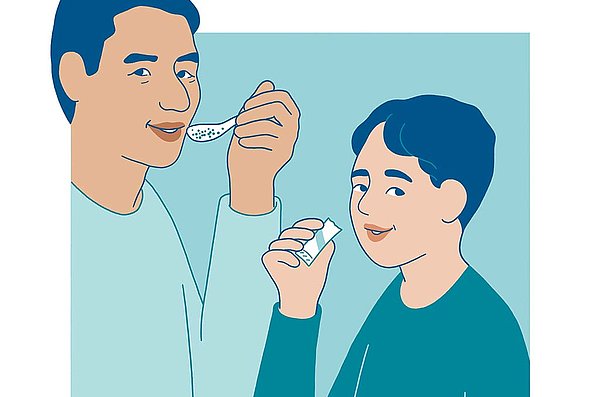In 1979, the Johns Hopkins University defined patient compliance as related to “the extent to which a person’s behavior (in terms of taking medications, following diets, or executing lifestyle changes) coincides with medical or health advice.” [1]
Patient compliance is closely related to the acceptance of the medication. The pharmaceutical industry has seen the need to focus on the root causes of non-acceptance and to look deeply into finding improvements. Novel approaches like optimizing the physical aspects of oral solid dosage forms by reducing tablet size were explored. On the other hand, several studies were conducted to mask the taste or smell of challenging active ingredients.
Medicinal products often have a bitter taste, leading to poor patient compliance, as patients can be reluctant to take the medicine or even refuse taking it altogether. Typical active pharmaceutical ingredients (APIs) known to have a bitter taste are macrolide antibiotics or penicillin, and anti-inflammatories like ibuprofen or quinine, as non-exhaustive examples. For instant release formulations, drug products dissolve in the saliva in the mouth and the API particles bind to the taste receptors on the tongue. The bitter taste receptors are mostly found on the posterior part of the tongue, which can lead to a higher rate of rejection of the medicines.
This situation is particularly challenging for caregivers of the pediatric population, as children have a higher amount of taste buds than adults [2], thus having a stronger sensitivity to bitterness.
For that reason, masking the bitter taste of the drugs is a key consideration in new pharmaceutical developments for pediatric patients.
Several techniques have been developed to be used for concealing the unpleasant taste [2]. The most popular methods are the addition of sweeteners or flavors, or the use of amino acids or drug-resin complexes. Considering population diversity and the recent studies about the connection between taste and ethnicity or gender, it is challenging to find the right balance of sweeteners or flavors that would have universal appeal worldwide. Furthermore, in cases of masking the taste of water-soluble drugs, the exclusive use of sweeteners even in combination with flavors isn’t sufficient because the OSD starts to disintegrate upon contact with saliva in the mouth, leading to a partial release of the bitter API.
Another way to cover up the bitter taste is to apply a coating layer, which can be easy to implement for different products. The coating formulation is very flexible as it can be applied on tablets, pellets and capsules by using a pan coater or a fluid bed. It provides a physical barrier, preventing the penetration of saliva and dissolution of the API in the mouth cavity.
In a recent study, Shin-Etsu developed a coating formulation based on an enteric coating polymer with a higher pH solubility than the pH of saliva in the mouth (pH=6.2), and a pore former to allow for disintegration in the acidic environment of the stomach. A typical enteric coating polymer dissolving at a pH higher than 6.2 is hypromellose acetate succinate, grade AS-H (Shin-Etsu AQOAT® AS-HG). Hypromellose 2910 with a viscosity of 6 mPas (PHARMACOAT® or TYLOPUR® 606) can be used as a pore former.
In table 1, three formulations based on those polymers are shown, whereas the ratio of enteric polymer and pore former were varied.
| Material | F1 w/w (%) | F2 w/w (%) | F3 w/w (%) |
|---|---|---|---|
| HPMCAS AS-HG | 6.3 | 3.5 | 6.3 |
| Hypromellose 2910 (6 mPas) | 0.7 | 3.5 | 6.3 |
| Ammonia (as NH3) | 0.08 | 0.045 | 0.009 |
| Purified Water | qs | qs | qs |
| Total | 100.0 | 100.0 | 100.0 |
These coating formulations were applied on caffeine based mini-tablets (diameter 3 mm, 20 mg, figure 1).
Figure 1: Mini-tablets and mini-tablet multi-tip-tooling.
To assess the taste masking property of the taste masking coating formulations, a specific technique requiring a low volume (5 mL) of simulated saliva was used to mimic the amount of media present in the oral cavity.
The very bitter substance quinine was used as reference API threshold value. For successful taste masking, the amount of caffeine dissolved should be below the onset of taste perception of quinine (0.000008 M, 2.595 g/mL) measured by using UV detection (Erweka DT720 dissolution tester equipped with UV analysis, = 275 nm) [3].
Therefore, one coated caffeine mini-tablet was put into an Ultra-Turrax tube drive vessel containing 5 mL simulated saliva. Mixing occured at 400 rpm for 5 min before a sample was drawn, and the sample was analyzed for caffeine content by UV spectroscopy (n=6 tablets).
The mini-tablets could be successfully coated without any agglomeration up to 20% weight gain in a coating pan (SolidLab 1 Bosch). The low amount of ammonia used for the coating formulation based on cellulose derivatives was easily evaporated during drying. The UV analysis of coated mini-tablets (Figure 2) with cellulose derivatives showed that a weight gain of 15-20% was optimal for masking the bitter taste of caffeine.
Figure 2: Concentration of caffeine in the simulated saliva after five minutes in the low-volume dissolution test (n=6, error bars indicate the standard deviation). The red line indicates the taste perception threshold for quinine (0.0025 mg/mL)
As a next step, dissolution profiles of the mini-tablets in gastric fluid (pH1.2) were obtained in order to see if the different coating formulations modify the dissolution profile in the stomach. By varying the ratio of both polymers, the API dissolution profile in standard dissolution testing in simulated gastric fluid was modified from immediate release to delayed release until fully enteric in acidic media (Figure 3). Those tablets can be presented to a tasting panel to assess their efficiency on humans.
Figure 3: Dissolution test of taste-masked mini tablets in pH=1.2 simulated gastric fluid (n=6, error bars indicate the standard deviation)
[1] Haynes RB. Introduction. In: Haynes RB, Taylor DW, Sackett DL, eds. Compliance in Health Care. Baltimore, MD: Johns Hopkins University Press
[2] Sohi H, Sultana Y, Khar RK. Taste Masking Technologies in oral pharmaceuticals, recent development and approaches. Drug Develop. Ind. Pharm. 2004;30(5): 429-448 - pubmed.ncbi.nlm.nih.gov/15244079/
[3] Gustafson, T., Taste masking assessment, AAPS 2017.

Solid pharmaceutical dosage forms, such as tablets and capsules, are the most used drug delivery systems, favored for their ease of production and patient preference.
Read more
Oral solid dosage forms (OSD) present numerous options, over semi-solids and liquids, to enhance patient acceptance to medicines.
Read more
In June 2022, Persistence Market Research presented a market outlook of orally disintegrating tablet (ODT) for the next years (2022 - 2025). According to this research “The ODT Market is likely to have compound annual growth rate (CAGR) of 8.5% over the forecast period.
Read more